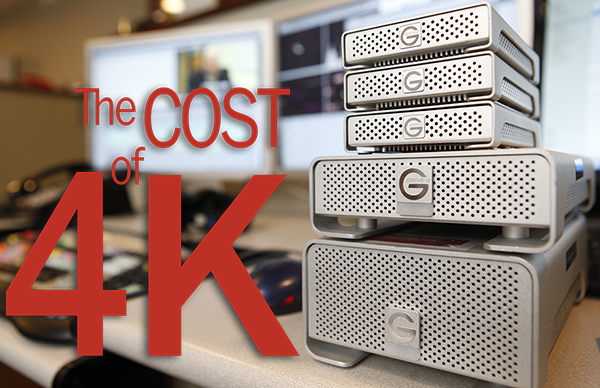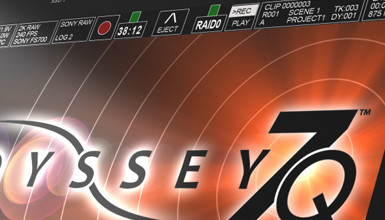After polling a number of industry sources, I decided to try and break down the production costs of shooting, data management, dailies creation and archiving in 4K to show that it isn't as intimidating as you might think.
Let's use a typical multi-camera one-hour television drama (such as Game of Thrones) shooting six hours of footage per day with nine cameras. And let's assume that everything is shot in ProRes 4444 at 24fps, just to make it a little easier to get some figures. Additionally, let's say they're using a camera that can shoot both formats, so the production equipment is the same, but the amount of media and storage will differ. This isn't a magical camera, by the way, there are plenty of cameras that offer 4K and 1080 recording options in the same codec, as well as external recorders like AJA's Ki Pro Quad or the new Odyssey 7Q from Convergent Design.
Shooting
An hour of ProRes 4444 1080/24p can average around 119GB; an hour of ProRes 4444 4K/24p will average 509GB. Assuming your recording media can hold 512GB, then each card will hold either 4 hours and 15 minutes of 1080 or 1 hour of 4K (I'm leaving space because a 512GB card almost never has 512GBs available to fill). So let's figure out how many cards we need. Nine cameras shooting six hours of footage total, means each camera is shooting 40 minutes of footage. You usually want to have at least one card per camera as a back up. So for this show, regardless of 1080 or 4K, the card count would remain the same: two cards per camera. However, you probably won't want to clear your cards until you hear from post that everything looks ok, so for safety let's say four cards per camera for a total of thirty-six 512GB cards.
Downloading
Using Thunderbolt to download your footage, one card at a time, it would take roughly 35 minutes per card for the 4K footage and roughly 8 minutes per card for the 1080 footage. With all cameras handing in their cards at the end of the day, it would take about 5 hours and 15 minutes to download the 4K footage and 1 hour and 12 minutes to download the 1080 footage.
The 4K footage will take up 3TB of space and the 1080 footage will take up 690GB of space (these figures are rounded up slightly for safety). For a multi-day 4K job you'll want a 6TB housing with two 3TB modular shuttle drives (one master and one backup), while both your DIT and dailies colorist will have housings which already come with the drives, so you'll have four drives in rotation from the start. For a multi-day 1080 job you'll want a 2TB housing with two 1GB modular shuttle drives.
Two 6TB housings with drives will cost roughly $1,600 total and two 2TB housings with drives will cost roughly $1,000.
Dailies Creation
Typical rates for dailies will run you about $750/hour of content for 4K footage and $500/hour for 1080 footage (according to a reputable post services facility in Los Angeles). That's $4,500/day for the 4K and $3,000/day for the 1080. This includes transcoding for offline editing as well as DVD burning services.
Archiving
Assuming that you are archiving to LTO-6, each LTO-6 tape holds 2.5TB of uncompressed data. You will need two tapes per day for the 4K footage and one tape for three days of 1080 footage. If an episode takes 8 days to shoot, that will mean sixteen tapes per 4K episode and three tapes per 1080 episode. At roughly $96/tape, the 4K episode costs $1,536 to archive and the 1080 episode costs $288 to archive.
Breakdown Per Episode:
| 4K | 1080 | |
| Shooting | No Difference | No Difference |
| Downloading | $1,600 | $1,000 |
| Dailies | $36,000 | $24,000 |
| Archiving | $1,536 | $288 |
| Total | $39,136 | $25,288 |
This is just one method of comparing your production's costs between 4K and HD. We understand that many other factors will contribute to the overall cost differential. But given our analysis above, we estimate that it costs about 55% more to produce 4K content over HD. Not quite the 400% you were probably expecting, is it? Hopefully, by breaking down the costs like this, I hope that I've managed to pull the curtain back on 4K and clear up some of the myths around its workflow.
Special thanks to Peter Price (Director of Post Production, Revolt TV) and Lewis Rothenberg (Digital Imaging Technician, Royal Pains) for their input on typical footage count and workflow.

















